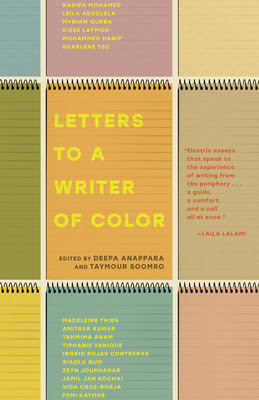by MK French
This collection is written by various writers of color, using empathy and wisdom to point out the conventions used in fiction. Why are novels written the way that they are, and using the structures that have become so familiar? They talk about using their backgrounds to lend authenticity to writing, censorship, the creation of art, humor, and giving themselves permission to be themselves and not a watered-down version for public consumption. Different cultures, genders, and sexualities are represented, giving us an array of opinions to look at our assumptions regarding what we read and how we evaluate it.
Amazon affiliate links are used on this site. A free book was provided for an honest review.
 |
| March 2023; Random House; 978-0593449417 audio, ebook, print (272 pages); anthology |
We open with an essay questioning truth in fiction, and the con that some people play regarding identity. Though other essays tackle different aspects of literature, it's still a topic thread running throughout. What determines an individual's true self, and how much of that belongs on the page? It's a question that always comes up, because the adage "write what you know" is there. Those from marginalized identities struggle with that question more, never feeling like their reality truly holds value. This can also be applied to story structure, as the three (or four or five) act structure tends to rule Western fiction. Other cultures have different traditions and focus in story, but that doesn't make it any less valid. Each of these writers puts forth a piece of their own history, and how that affected their writing and techniques. The phrases used, the choice of story to tell, the details to make it feel "authentic," all stem from the background each author has. The country or culture of origin, educational background, literary history and manner of getting published all play a role.
This collection of essays poses questions with no easy answers. It feels like a Fine Arts or literature course, which is rather the point. Each essay has suggested reading at the end, as well as examples within the text. The authors brought their own histories to the questions, showing us how to answer them. Vida Cruz-Borja talks about this frequently, and I liked seeing practical applications in essays, especially those by Femi Kayode and Xiaolu Guo. Bring the details that are important to characters. Show the village their ancestors grew up in. Make them fully realized people, not stereotypes or cardboard cutouts. Honor trauma, don't exploit it simply for shock value. Give characters of color the same careful attention in the world-building stages that white ones get, without fear of rejection or misunderstanding. These stories will get published and read, and the reader will see them as authentic.
Buy Letters to a Writer of Color at Amazon
Born and raised in New York City, M.K. French started writing stories when very young, dreaming of different worlds and places to visit. She always had an interest in folklore, fairy tales, and the macabre, which has definitely influenced her work. She currently lives in the Midwest with her husband, three young children, and a golden retriever.
Enjoyed this post? Never miss out on future posts by following us. Get even more book news in your inbox, sign up for our newsletter today! Girl Who Reads is an Amazon advertising affiliate; a small commission is earned when purchases are made at Amazon using any Amazon links on this site. Thank you for supporting Girl Who Reads.




.png)
















0 comments:
Post a Comment